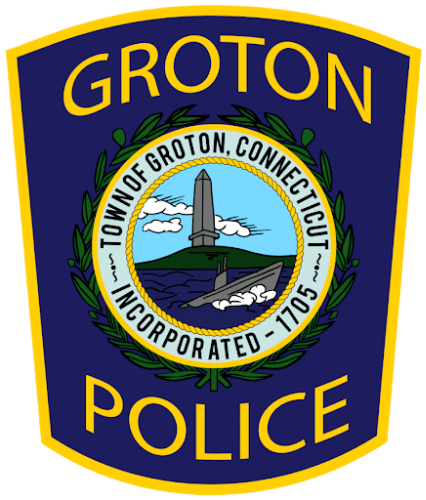The Town of Groton, Connecticut, was incorporated by an act of the Connecticut General Assembly in 1705. Also known as, “The Submarine Capital of the World”, Groton is the home to the United States Naval Submarine Base as well as submarine manufacturer General Dynamics, Electric Boat Division and Pfizer Pharmaceuticals research facility.
From its earliest days, Groton had various incarnations of local police. In 1704 there were “Town Constables” who did not receive an established monetary compensation but were paid for work such as upholding laws and protecting property. They were not assigned to conduct patrols, but only worked in their capacity as a constable when called upon to do so by proper authority.
In 1891 the Board of Selectmen appointed a Sheriff and Deputy Sheriff, and nine years later in 1900 three men were appointed as “Patrolmen” by the Town. The department traces its lineage and honors to this group of officers and recognizes 1900 as the beginning of the first police department in the Town of Groton. Much like the Constables before them, these three “Patrolmen” did not receive a set salary but rather were paid according to the job or arrests they made.
In 1935 the first regularly paid “Patrolmen” for the Police Department were hired for the Mystic and Noank sections of Groton. By 1939 a third regularly paid “Patrolman” was added and an act was passed in the Connecticut General Assembly creating a regular police department with the town’s First Selectman, Charles T. Crandall, as the unofficial Chief of Police.
Between 1944 – 1946 the police department increased in size to ten “Patrolmen”, due to the increase in war workers. Four of the newly-hired patrolmen were assigned to the Fort Hill Homes area and their salaries were paid for by the U.S. Government.
Also in 1946 Mrs. Carolina II. Weeman became the first female Groton Officers when she was appointed as a “Special Constable” for the Police Department.
In October 1947 the Board of Police Commissioners established a Police Officer’s Rules of Conduct.
In 1952 the Board of Police Commissioners established Regulations for Police as well as working conditions. They also formally established the position of “Chief of Police”, promoting John F. Scroggins to Chief and establishing a Detective Bureau and outlining the duties of all officers. In 1956 a rank system was established consisting of the Chief of Police, two Captains, a Detective Lieutenant, and three Sergeants.
During the 1960’s Groton’s population and industry exploded with the establishment of Navy Housing, FieldCrest Estates and Long Hill Road businesses; as well as the expansion of General Dynamics’ Electric Boat, Pfizer and the Submarine Base.
In 1963 Robert E. Falvey, a World War II veteran and recipient of the Silver Star Medal became the department’s 2nd Chief of Police. In 1964 Chief Falvey presented the Groton Town Council a detailed report outlining departmental reorganization and by 1968 staffing grew to 41 officers. During this period “area cars” were introduced and Officers were assigned motor patrols in one of five (5) patrol sectors under the supervision of a Patrol Sergeant.
On July 9, 1977 Officers moved into the new police headquarters on Groton Long Point Road across from Robert E. Fitch Senior High School. This modern police station included separate work areas for patrol, detectives, and administrative personnel. It also included a cell block, exercise room, both male and female locker room facilities and eight-point indoor shooting range. In April 1981 a 9-1-1 center was added in the rear of the building.
Following the retirement of Chief Robert E. Falvey in 1983, his nephew, Thomas M. Falvey, was appointed Chief of Police. During his tenure a dedicated Community Police Substations were established throughout town, the use of laptop computers in cruisers, a motorcycle traffic unit, and a bicycle patrol unit were introduced.
In 1995 David N. Vanasse was then appointed Chief of Police and he served in this capacity for a decade. Under his leadership. The facility was expanded in 1999 and the Youth and Records Divisions were expanded and a new building addition was built to house the much-expanded Emergency 9-1-1 PSAP center. During this time the police department’s dispatchers were consolidated into the “Groton Emergency Communications Center under the direction of the Town’s Emergency Management Director.
In 2005 Chief Vanasse retired and Kelly M. Fogg was appointed Chief of Police. On August 27, 2009 a new Animal Control Facility was dedicated behind the police station.
In 2011 Chief Kelley Fogg retired and Michael J. Crowley was appointed Chief of Police, serving until early 2014. From February 2014 until July 2015 there was no formally appointed Chief of Police.
In July 2015 Louis J. Fusaro, Jr. was appointed Chief of Police. Chief Fusaro was the first person appointed Chief from outside the agency, having previously served with the Connecticut State Police. During his tenure the department was the first municipal agency to go live on the Connecticut Statewide Telecommunication System’s 800 MHz Radio System. The department undertook efforts to overhaul infrastructure, policies and equipment and in 2017 it was the first municipal agency in eastern Connecticut to adopt Body Worn Cameras.
In 2018 the Emergency Communication Center and Emergency Management functions were consolidated into the Police Department, with the Chief of Police assuming the duties of Emergency Management Director.
In 2022 civilian Community Outreach Specialists (social workers) positions were established and staffing grew to 70 sworn personnel. A “Citizens and Police Committee” consisting of seven (7) members was established. In 2023, the department received Connecticut POST-C Accreditation and in March of 2024 received nationally recognized accreditation through the Commission on Accreditation for Law Enforcement Agencies (CALEA).
Today the Town of Groton Police Department consisting of 70 sworn full-time Officers, 3 Supernumerary Officers, 13 full-time and 3 part-time Telecommunicator positions, 2 Animal Control Officers, 2 Public Safety Community Outreach Specialists, a Police Support Specialists, Executive Assistant and 2 Clerical Support staff and 3 Part-time Community Service Officers.
